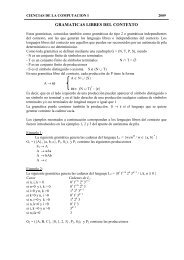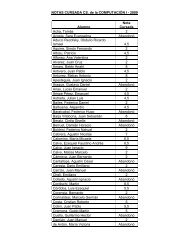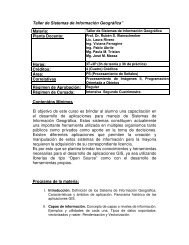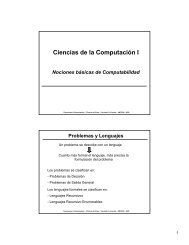Libro de Resúmenes / Book of Abstracts (Español/English)
Libro de Resúmenes / Book of Abstracts (Español/English)
Libro de Resúmenes / Book of Abstracts (Español/English)
Create successful ePaper yourself
Turn your PDF publications into a flip-book with our unique Google optimized e-Paper software.
Resumenes 175<br />
los parámetros son todos positivos teniendo diferentes significados<br />
biológicos y los sistemas son analizados en el primer cuadrante. Se<br />
<strong>de</strong>muestra que:<br />
1) El punto <strong>de</strong> equilibrio (0,0) siempre es punto silla y que la naturaleza <strong>de</strong><br />
(K, 0) <strong>de</strong>pen<strong>de</strong> <strong>de</strong> la existencia <strong>de</strong> puntos <strong>de</strong> equilibrio al interior <strong>de</strong>l primer<br />
cuadrante.<br />
2) Existen condiciones en los parámetros para los cuales hay dos puntos <strong>de</strong><br />
equilibrio al interior <strong>de</strong>l primer cuadrante (positivos), o bien uno <strong>de</strong><br />
multiplicidad dos, o ninguno.<br />
3) Cuando colapsan los puntos críticos positivos, este único punto pue<strong>de</strong> ser<br />
un punto cúspi<strong>de</strong> <strong>de</strong> codimensión 2 (bifurcación <strong>de</strong> Bogdanovic-Takens).<br />
4) Existe una región en el espacio <strong>de</strong> parámetros don<strong>de</strong> dos ciclos límites<br />
pue<strong>de</strong>n coexistir.<br />
La extinción <strong>de</strong> la población <strong>de</strong> <strong>de</strong>predadores es posible porque el<br />
punto (K,0) es atractor cuando existen dos puntos <strong>de</strong> equilibrio positivos.<br />
Comparative study <strong>of</strong> Gause type predator-prey mo<strong>de</strong>ls with<br />
nonmonotonic functional response <strong>of</strong> rational type<br />
In this work we make a comparative analyze <strong>of</strong> two <strong>de</strong>terministic<br />
continuous-time predator-prey mo<strong>de</strong>ls <strong>of</strong> Gause type consi<strong>de</strong>ring a Holling<br />
type IV functional response which is nonmonotonic [10].<br />
The Gause type mo<strong>de</strong>ls [4] are characterized by the predator<br />
numerical response which is a function <strong>of</strong> functional response, correspond to<br />
a compartimental mo<strong>de</strong>ls or mass action, and are <strong>de</strong>scribed by a differential<br />
equations system <strong>of</strong> the form:<br />
⎧ dx<br />
⎪ = F(<br />
x)<br />
− y p ( x)<br />
dt<br />
X : ⎨<br />
⎪ dy<br />
= ( c p(<br />
x)<br />
− d)<br />
y<br />
⎪⎩<br />
dt<br />
where x = x(t) and y = y(t) indicate the predator and prey population size<br />
respectively for t > 0 (number <strong>of</strong> individual, <strong>de</strong>nsity or biomass). Function<br />
F(x) represents the prey growth rate and function p(x) is the predator<br />
functional response or consumption rate, that is, it indicates the change in<br />
the <strong>de</strong>nsity prey attached per unit time per predator as the prey <strong>de</strong>nsity<br />
changes.<br />
This function <strong>de</strong>scribes a type <strong>of</strong> antipredator behavior called group<br />
<strong>de</strong>fense or aggregation, that is, a phenomenon whereby predators<br />
<strong>de</strong>crease, or even prevented altogether, due to the increased ability <strong>of</strong> the<br />
prey to better <strong>de</strong>fend or disguise themselves when their number are large<br />
qx<br />
enough [2, 4, 9, 12, 13, 14, 15]. Most employed function is h(<br />
x)<br />
= 2<br />
x + a<br />
[5, 6, 7, 8, 9], <strong>de</strong>duced in [2]. However, in [15], the more general form<br />
qx<br />
h(<br />
x)<br />
= is used.<br />
2<br />
x + bx + a<br />
In above works [1, 11] we have <strong>de</strong>monstrate that using different<br />
form to nonmonotonic functional response change the bifurcation diagram<br />
<strong>of</strong> system and in this work we pretend find a generalization <strong>of</strong> this results.<br />
Mo<strong>de</strong>ls that we will study are <strong>de</strong>scribed by the following Kolmogorov type<br />
differential equations systems [3]:



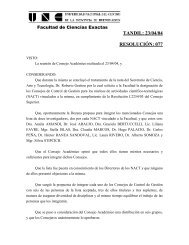
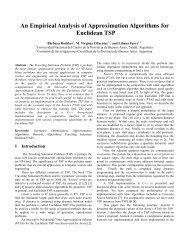
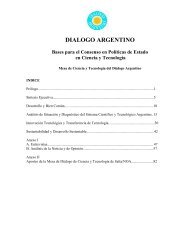


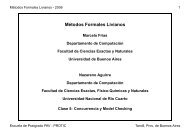
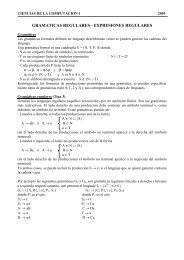

![Clase 13 [pdf]](https://img.yumpu.com/19616969/1/190x245/clase-13-pdf.jpg?quality=85)

